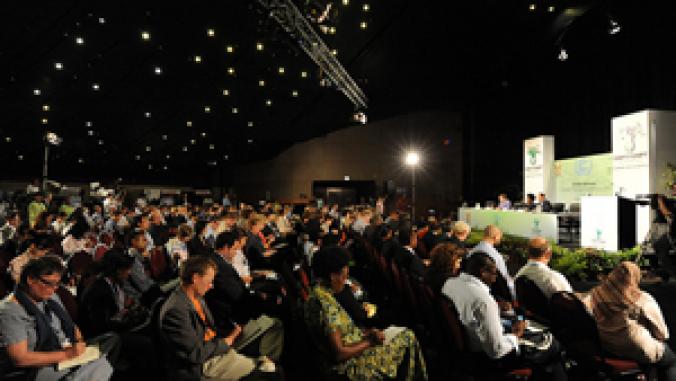View from the C-Suite: Autodesk CEO Carl Bass
<p>GreenBiz.com’s Heather King talks with Autodesk CEO Carl Bass about how design software helps advance building and product efficiency, the company’s "investment" in clean tech, and their drive to teach kids like Max and Maya in Oakland, Calif. how to build anything better.</p>

Autodesk is a world leader in 3D design software for the manufacturing, building, engineering and entertainment industries. Since introducing AutoCAD in 1982, the company has grown from 16 to over 7,000 employees and $2 billion in annual revenues. Autodesk sells a broad portfolio of software tools for designers and engineers in over 10 million companies -- including 99 of the Fortune 100. Their products are instrumental in shaping much of the built world -- from buildings, roads, utilities to entire cities as well as cars, electronics, packaging and shoes. Autodesk sees tremendous opportunity to address the world's most pressing environmental problems through technology.
Greenbiz.com's Heather King talks with CEO Carl Bass about how design software helps advance building and product efficiency, the company's 'investment' in clean tech, and their drive to teach kids like Max and Maya in Oakland, California how to build anything better.
Heather King: Autodesk is ubiquitous in many mature markets. In what ways is sustainability a market opportunity for Autodesk?
 Carl Bass: The real value of our software is that it allows people to better understand the things they build before they build them. Sustainability is a perfect example. Information about the design and building process makes a huge difference in terms of energy efficiency and other sustainability factors.
Carl Bass: The real value of our software is that it allows people to better understand the things they build before they build them. Sustainability is a perfect example. Information about the design and building process makes a huge difference in terms of energy efficiency and other sustainability factors.
For example, a builder may ask, "If I took this building and I rotated it 20 degrees on the site, would it take more or less energy to heat or cool?" Most engineers and architects cannot adequately answer this question. Replicate this challenge in thousands of building design decisions such as the size of the eaves and the selection of materials. Our technology helps people make informed decisions at the beginning of the process. We are in the unique position to offer tools that help our customers build more energy-efficient, sustainable structures. This applies to manufacturing as well as construction processes.
Early on, the greatest interest and opportunity has been in building and construction. Architects and engineers have taken up efficiency challenges strongly. Manufacturers have been more divided; some are wholeheartedly endorsing the idea and others give a blank stare when asked about the sustainability of their products. We see that changing.
HK: Autodesk appears to be playing a "venture role" in the Clean Tech industry by "granting" valuable software to clean tech startups. How does this program dovetail with Autodesk's business strategy?
CB: Clean Tech is particularly interesting for us. It involves the manufacture of products that materially reduce energy needs. We launched a program in July, 2009 to grant software to clean tech start-ups. These companies are at the very early stages of an idea. They're just raising venture capital. We provide the most relevant software to their needs. If they're doing biomass the technology tools are completely different than if they're designing an electric vehicle. The program has been well received. We now support over 500 U.S. companies. As of Spring 2010, we're offering the same program in Europe.
The reason for this program is two-fold. First, we want to do our part and give the best tools to people who are working on important issues -- like climate change and the environment. Second, certain of these companies will become successful over time. If they become successful using our products, it's likely they'll become real customers.
HK: Autodesk has a history of amplifying its growth through strategic acquisitions. Do you expect to grow your position in clean tech and sustainability through acquisition?
CB: For a company of our size, we have been modest acquirers. We have acquired more companies than average, but they tend to be smaller entities. We are interested in finding a technology and/or people with passion around an expertise. We do a fair number of partnerships as well. When it comes to clean tech and sustainable design, we've done both.
We've done partnerships with Granta and Sustainable Minds. These companies each have tools to help people do more sustainable design. On the acquisition side, most of our acquisitions are not wholly targeted towards clean tech but are certainly very useful there. For example, we acquired Ecotect, which offers energy analysis for buildings.
HK: Autodesk is moving into the consumer market. What is driving this decision and in what way does sustainability play into this move?
CB: We wanted to do two things: Give people access to our tools earlier in their careers and enable our customers to better support their customers.
We have expanded our focus on education. It's our belief that, as a business, we need to contribute to American education which is sorely lagging compared to peers in the developed and less developed world. Historically, we've done a lot with higher education, with groups like Project Lead The Way and First Robotics.
Now, we are doing more in secondary and middle schools. Teachers are helping kids use our products for game design and special effects for videos. I met a teacher locally who has developed a seven-year curriculum around our products. He is teaching the Max-es and Maya-s in the Oakland, California school districts how to become better designers. It's totally cool.
We've also been interested in helping our customers reach their customers with our technology. We support many people who design for the home -- furniture, lighting, appliances, and more. So we built a product that allows consumers to do interior decorating in their house. It's a freeware-based application that allows our customers to offer their own designs and products. Another example is our work with car companies. We help them give their customers user manuals and product selectors. Now their customers can use a kiosk based tool to configure their order: "I want this kind of car in this color with these four options."
HK: Autodesk's recent financials are strong and investors have been bullish. To what extent do you attribute this to your clean tech and sustainability efforts?
CB: The vast majority of our sales have some connection to sustainable design. That said, the investment community, with the exception of the investors who are invested in clean tech, is driven by profit. It is hard to attribute the rise in our stock price or market valuation to our work in sustainability or clean tech initiatives.
For many of our stakeholders, sustainability and efficiency are critically important. Our customers truly appreciate it, particularly our architecture, engineering and construction customers. This is top of mind for them; they are winning or losing projects on their ability to deliver better, more sustainable projects. It is the single biggest issue for our employees. I also think that the best and brightest are working on sustainability and climate change; our commitment brings us into contact with them.
HK: The 2010 climate talks at Cancun underscored the importance of businesses working with governments to advance public and private solutions to climate change. Is Autodesk working with policymakers?
CB: In general, we've been enthusiastic supporters of legislation moving to a more sustainable future. I would say that government has actually been strong with regard to building standards and codes -- especially in California, New York, and London. I think we will see more national laws within a few years. There's more work to be done with existing buildings. Most energy consumption in buildings has to do with existing structures as opposed to new construction.
With regard to other sectors of the economy -- transportation, manufacturing -- the mandates are less clear and government has been less involved. We've been working on that front.
HK: What are you most excited about looking forward?
CB: The most exciting thing is the whole notion of solving difficult, important, complex global challenges through computing. Most people don't understand is how cheap computing has become. The spot price for an hour of CPU time is now about five cents. My commute costs me $7.00. It's 15 times more expensive to move me from Oakland, California to my office than it is to run a computer all day. We are reaching the point of "infinite computing" -- where computing power is scalable and virtually free.
This means that we can make more expansive use of computers to build and rebuild our future -- better, more efficiently and more sustainably. It's exciting to think about using this virtually free resource to manage increasingly scarce natural resources.





